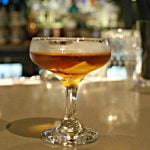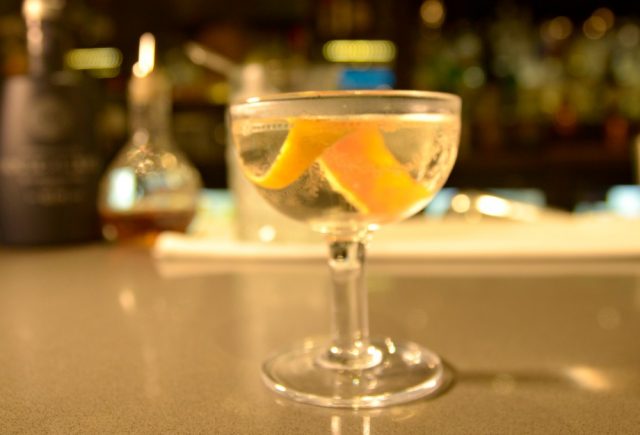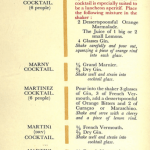History of the Martini Cocktail
From Alessandro Borelli of DINE, Edinburgh.
There’s no cocktail more distinctly American than the Martini. It’s strong, sophisticated and sexy. It’s everything we hope to project when ordering one.
No one really knows the exact origins of the Martini. The widely accepted theory is that it evolved from the Martinez, or so-called the ‘Father’ of the Martini, or at least acknowledged to have had a huge amount of influence on it. The Martinez’s origins belong in a cloudy haze of uncertainty.

Martinez
This lineage is complicated by numerous other variations that emerged between 1882 and 1910, creating a family of related drinks such as the Marguerite, Martine, Martigny, Martina, Martineau and Bradford á la Martini.
Going back to the first known written recipe of the Martinez, where it appeared in O.H. Byron’s 1884 Book “The Modern Bartender” as a variation of the Manhattan. The people of Martinez claim that the namesake Martinez cocktail was first produced in their town.
There is even a plaque proudly hung up there that commemorates its creation. It is possible this was done in an effort to protect and certify their story. If true, this could validate Julio Richelieu’s claim. In about 1870, during the gold rush, a customer walked into Richelieu’s bar in the town of Martinez (California) after a hard day of digging and asked for some boozy refreshment. He was served a gin and vermouth drink, with a pickled fruit popped in and thus created the star of this legacy.
By the time the miner got through a few of these, he could no longer pronounce the “Z,” and thus, the “Martini” was born. Or so goes one legend. Not only was the gold rush well and truly over by then, but no one could even find a listing of the man’s existence. Whether this is the real history behind such an iconic drink, will always remain a mystery.
Here at Dine, we think that one of the main reasons is in 1867 Martini & Rossi started to export their sweet vermouth to the US, and the majority of the gin-based cocktails were mixed with the sweet and herbaceous Italian aperitif.
Martinez
20ml Old Tom
20ml Sweet Vermouth
2 dash Orange Curaçao Liqueur
1 dash Angostura Aromatic Bitters
Orange Peel
This sweet version of the Martini was the one that followed throughout the 1880’s but an appetite for drier drinks became ubiquitous by the 1920s.
This also coincides with the availability of such ingredients that were necessary to make it, and the ban on drinking alcohol in America. This led many American natives to European shores, including some of the best bartenders in America, who thus became influenced by a European taste and style, which is distinctively drier.
Robert Vermeire’s “Cocktails: How to Mix Them” verifies this change, presenting a drier Martinez than previous recordings using Dry French vermouth. It is not that dissimilar to Harry Craddock’s version. “The Savoy Cocktail Book” affirms this type of change to Dry French vermouth, further establishing it as a dry gin cocktail. During the 1800s, many drinks were named very simply (gin cocktail, fancy gin cocktail, gin cobbler, gin daisy, etc.).
Dry Martini Cocktail
20ml Plymouth Gin
20ml Noilly Prat Dry Vermouth
FROM THE SAVOY COCKTAIL BOOK
2 Dash Orange Bitters
Shake & Double strain
Lemon Peel
When “The Savoy Cocktail Book” was first published, it not only enriched the style of the times―it became part of it. The book captures the spirit of the roaring 20s with its historic recipes created by the Dean of the cocktail Harry Craddock, a bartender that left America during the Prohibition to work as a Head Barman at The American Bar, the place to be seen drinking “mixed drinks” in London.
George Gershwin, Frank Sinatra, Dorothy Parker, Humphrey Bogart, Coco Chanel, Ernest Hemingway, Winston Churchill, are a few of the famous guests of the American Bar at that time, and the Martini Cocktail was the drink of the moment.
Unfortunately gin gradually lost popularity in favour of vodka after WWII, mainly because gin’s fans were ageing and young people turned their attention to a cool new spirit – vodka. Several vodka brands were launched with slick advertising campaigns that made Swinging Sixties teenagers change their allegiances in droves.

“Shaken not Stirred” is a catch phrase of Ian Fleming’s fictional British Secret Service agent James Bond and describes his preference for the preparation of his Vodka Martini. Its first appearance is dated 1956 in the novel Diamonds are Forever. Bond ordered a total of 19 Vodka Martinis (rigorously Russian Vodka) throughout Fleming’s novels.
Bond Vodka Martini
30ml Stoli Vodka
5ml Noilly Prat Dry Vermouth
Shake & Double Strain
Lemon Peel
Scientists, specifically biochemists, and Martini connoisseurs have investigated the difference between a shaken or stirred Martini. The Department of Biochemistry at the University of Western Ontario in Canada conducted a study to determine if the preparation of a Martini has any influence on their antioxidant capacity.
The study found that the shaken gin martinis were able to break down hydrogen peroxide and leave only 0.072% of the peroxide behind, versus the stirred gin martini, which left behind 0.157% of the peroxide. Thus, a shaken Martini contains more antioxidants than a stirred one.
For years, gin languished in the shadows of vodka, considered as the grandparent’s drink of choice. Thankfully to the resurgence in craft cocktails and reinterpretation of the old school recipe, gin has made a strong come back, and we are now living the so called Ginaissance.
The Duke’s Hotel in London is the Worldwide Ambassador for the Gin Martini. Their theatrical and meticulous preparation adds something magical to the ritual itself. The Duke’s Hotel is tucked away in an exclusive corner of Mayfair, only a brisk walk away from Buckingham Palace. Stroll down St James’s Street and take a side-street to enter the minute courtyard to find this discreet spot. Dukes Bar may come across a touch pretentious at first glance, mainly due to the imposing décor and grand location, but don’t let that put you off.
In Dukes, there is the very intimate and traditional British ambience, all Martinis are prepared and served right in-front of you on a little vintage

Duke’s Martini
trolley. So, you can be sure all the drinks are fresh and have been given the appropriate care. All the stirring is done by the skilful hands of unrivalled showmanship by the legendary Bar Manager Alessandro Palazzi, a true Master of the Martini.
Duke’s Martini
30ml Darnley’s Original
5 dash Noilly Prat Dry Vermouth
Organic Lemon Peel
What makes the Duke’s Martini stand out from other recipes, is that the spirit used for the cocktails comes straight from a -26 degrees Celsius freezer, and so does the Martini glass. It sits like milk due to its sub-zero temperature and the absolute absence of dilution, and for this very reason Mr. Palazzi always recommends only two Martinis per person.
If you want to learn even more and sample some of these classic martini recipes, we highly recommend that you try The Martini Experience at DINE, Edinburgh.
Alessandro is a knowlegable host, with an incredible passion for martinis. During the session you will learn about the different types of martinis, sample them and learn to create your very own version.
Watch Alessandro create a classic martini here.


